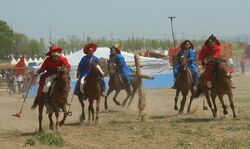Tagu
 Traditional Tagu, played in a regional game in Bukhae Province in Zhenia. | |
| Highest governing body | International Tagu Association (ITA) |
|---|---|
| Nicknames | Strike-ball |
| Earliest recorded playing | 320 BC, the Zhen dynasty |
| Registered players | 90,000+ |
| Clubs | 91 |
| Characteristics | |
| Contact | Yes |
| Team members | 5 per side |
| Mixed gender | No |
| Type | Outdoor, field equestrian sport |
| Equipment | Horse (not required for Ground Tagu), Tagu lance, ball, protective wear |
| Venue | Tagu field/arena |
| Presence | |
| Country or region | Zhenia |
Tagu (Zhenian: 打球/타구) is an equestrian team sport, revolving around two teams of five players each pursuing a ball on horseback.
Originating from traditions of Yemeg Zhenia nomadic groups in antiquity, it was adapted into a nationwide pastime during the Zhen dynasty when it was introduced as a part of a training course for cavalry units and infantry lancers. It took its modern, current form in 1870, following the establishment of the Empire of Zhenia, when formal rules and protective gear were introduced. Since then, it has become one of the most popular sports in Zhenia, while it has also been played in professional leagues in other nations as well.
Tagu, revolving around two opposing teams of five players each and a ball, is played by scoring goals with a long lance by striking the ball through the opposing team's goal, located on either side of the field. Although Tagu was originally intended to be played on horseback, Ground Tagu, a derivative of Tagu, does not involve any horses; otherwise, its rules are identical to equestrian Tagu.
